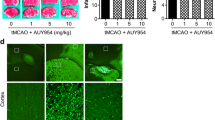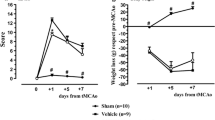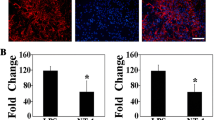Abstract
Effective therapeutic measures against the development of brain edema, a life-threatening complication of cerebral ischemia, are necessary to improve the functional outcome for the patient. Here, we identified a beneficial role of purinergic receptor P2X7 activation in acute ischemic stroke. Involvement of P2X7 in the development of neurological deficits, infarct size, brain edema, and glial responses after ischemic cerebral infarction has been analyzed. Neurologic evaluation, magnetic resonance imaging, and immunofluorescence assays were used to characterize the receptor’s effect on the disease progress during 72 h after transient middle cerebral artery occlusion (tMCAO). Sham-operated animals were included in all experiments for control purposes. We found P2X7-deficient mice to develop a more prominent brain edema with a trend towards more severe neurological deficits 24 h after tMCAO. Infarct sizes, T2 times, and apparent diffusion coefficients did not differ significantly between wild-type and P2X7−/− animals. Our results show a characteristic spatial distribution of reactive glia cells with strongly attenuated microglia activation in P2X7−/− mice 72 h after tMCAO. Our data indicate that P2X7 exerts a role in limiting the early edema formation, possibly by modulating glial responses, and supports later microglia activation.





Similar content being viewed by others
Abbreviations
- ADC:
-
Apparent diffusion coefficient
- AQP4:
-
Aquaporin 4
- CCA:
-
Common carotid artery
- DWI:
-
Diffusion weighted image
- ECA:
-
External carotid artery
- ICA:
-
Internal carotid artery
- MCA:
-
Middle cerebral artery
- MCAO:
-
Middle cerebral artery occlusion
- P2X7−/− :
-
P2X7 receptor knockout
- NMR:
-
Nuclear magnetic resonance
- pMCAO:
-
Permanent middle cerebral artery occlusion
- RARE:
-
Rapid acquisition with relaxation enhancement
- ROI:
-
Region of interest
- tMCAO:
-
Transient middle cerebral artery occlusion
- VOI:
-
Volume of interest
- WT:
-
Wild-type
References
Del Puerto A, Wandosell F, Garrido JJ (2013) Neuronal and glial purinergic receptors functions in neuron development and brain disease. Front Cell Neurosci 7:197
Franke H, Grummich B, Hartig W, Grosche J, Regenthal R, Edwards RH, Illes P, Krügel U (2006) Changes in purinergic signaling after cerebral injury—involvement of glutamatergic mechanisms? Int J Dev Neurosci 24(2–3):123–132
Oliveira JF, Riedel T, Leichsenring A, Heine C, Franke H, Krügel U, Nörenberg W, Illes P (2011) Rodent cortical astroglia express in situ functional P2X7 receptors sensing pathologically high ATP concentrations. Cereb Cortex 21(4):806–820
Domercq M, Perez-Samartin A, Aparicio D, Alberdi E, Pampliega O, Matute C (2007) P2X7 receptors mediate ischemic damage to oligodendrocytes. Glia 58(6):730–740
Nishida K, Nakatani T, Ohishi A, Okuda H, Higashi Y, Matsuo T, Fujimoto S, Nagasawa K (2012) Mitochondrial dysfunction is involved in P2X7 receptor-mediated neuronal cell death. J Neurochem 122(6):1118–1128
Monif M, Burnstock G, Williams DA (2010) Microglia: proliferation and activation driven by the P2X7 receptor. Int J Biochem Cell Biol 42(11):1753–1756
Kimbler DE, Shields J, Yanasak N, Vender JR, Dhandapani KM (2007) Activation of P2X7 promotes cerebral edema and neurological injury after traumatic brain injury in mice. PLoS One 7(7):e41229
Ryu JK, McLarnon JG (2008) Block of purinergic P2X7 receptor is neuroprotective in an animal model of Alzheimer’s disease. Neuroreport 19(17):1715–1719
Lambertsen KL, Biber K, Finsen B (2012) Inflammatory cytokines in experimental and human stroke. J Cereb Blood Flow Metab 32(9):1677–1698
Margaill I, Plotkine M, Lerouet D (2005) Antioxidant strategies in the treatment of stroke. Free Radic Biol Med 39(4):429–443
Alves LA, Bezerra RJ, Faria RX, Ferreira LG, da Silva FV (2013) Physiological roles and potential therapeutic applications of the P2X7 receptor in inflammation and pain. Molecules 18(9):10953–10972
Yanagisawa D, Kitamura Y, Takata K, Hide I, Nakata Y, Taniguchi T (2008) Possible involvement of P2X7 receptor activation in microglial neuroprotection against focal cerebral ischemia in rats. Biol Pharm Bull 31(6):1121–1130
Myer DJ, Gurkoff GG, Lee SM, Hovda DA, Sofroniew MV (2006) Essential protective roles of reactive astrocytes in traumatic brain injury. Brain 129(Pt 10):2761–2772
Suzuki T, Hide I, Ido K, Kohsaka S, Inoue K, Nakata Y (2004) Production and release of neuroprotective tumor necrosis factor by P2X7 receptor-activated microglia. J Neurosci 24(1):1–7
Le Feuvre R, Brough D, Rothwell N (2002) Extracellular ATP and P2X7 receptors in neurodegeneration. Eur J Pharmacol 447(2–3):261–269
Solle M, Labasi J, Perregaux DG, Stam E, Petrushova N, Koller BH, Griffiths RJ, Gabel CA (2001) Altered cytokine production in mice lacking P2X7 receptors. J Biol Chem 276(1):125–132
Engel O, Kolodziej S, Dirnagl U, Prinz V (2011) Modeling stroke in mice - middle cerebral artery occlusion with the filament model. J Vis Exp 47:2423
Menzies SA, Hoff JT, Betz AL (1992) Middle cerebral artery occlusion in rats: a neurological and pathological evaluation of a reproducible model. Neurosurgery 31(1):100–107
Dijkhuizen RM, Nicolay K (2003) Magnetic resonance imaging in experimental models of brain disorders. J Cereb Blood Flow Metab 23(12):1383–1402
Ito D, Tanaka K, Suzuki S, Dembo T, Fukuuchi Y (2001) Enhanced expression of Iba1, ionized calcium-binding adapter molecule 1, after transient focal cerebral ischemia in rat brain. Stroke 32(5):1208–1215
Gever JR, Cockayne DA, Dillon MP, Burnstock G, Ford AP (2006) Pharmacology of P2X channels. Pflügers Arch 452(5):513–537
Eriksdotter-Nilsson M, Bjorklund H, Olson L (1986) Laminin immunohistochemistry: a simple method to visualize and quantitate vascular structures in the mammalian brain. J Neurosci Methods 17(4):275–286
Ji K, Tsirka SE (2012) Inflammation modulates expression of laminin in the central nervous system following ischemic injury. J Neuroinflammation 9:159
Gu BJ, Wiley JS (2006) Rapid ATP-induced release of matrix metalloproteinase 9 is mediated by the P2X7 receptor. Blood 107(12):4946–4953
Hill LM, Gavala ML, Lenertz LY, Bertics PJ (2010) Extracellular ATP may contribute to tissue repair by rapidly stimulating purinergic receptor X7-dependent vascular endothelial growth factor release from primary human monocytes. J Immunol 185(5):3028–3034
Rha JH, Saver JL (2007) The impact of recanalization on ischemic stroke outcome: a meta-analysis. Stroke 38(3):967–973
Tanaka Y, Fukumitsu H, Soumiya H, Yoshimura S, Iwama T, Furukawa S (2012) 2-decenoic acid ethyl ester, a compound that elicits neurotrophin-like intracellular signals, facilitating functional recovery from cerebral infarction in mice. Int J Mol Sci 13(4):4968–4981
Davis MF, Lay C, Frostig RD (2013) Permanent cerebral vessel occlusion via double ligature and transection. J Vis Exp (77)
Yeung PK, Lo AC, Leung JW, Chung SS, Chung SK (2009) Targeted overexpression of endothelin-1 in astrocytes leads to more severe cytotoxic brain edema and higher mortality. J Cereb Blood Flow Metab 29(12):1891–1902
Walberer M, Blaes F, Stolz E, Muller C, Schoenburg M, Tschernatsch M, Bachmann G, Gerriets T (2007) Midline-shift corresponds to the amount of brain edema early after hemispheric stroke – an MRI study in rats. J Neurosurg Anesthesiol 19(2):105–110
Lenglet S, Montecucco F, Denes A, Coutts G, Pinteaux E, Mach F, Schaller K, Gasche Y, Copin JC (2014) Recombinant tissue plasminogen activator enhances microglial cell recruitment after stroke in mice. J Cereb Blood Flow Metab 34(5):802–812
Franke H, Günther A, Grosche J, Schmidt R, Rossner S, Reinhardt R, Faber-Zuschratter H, Schneider D, Illes P (2004) P2X7 receptor expression after ischemia in the cerebral cortex of rats. J Neuropathol Exp Neurol 63(7):686–699
Cherry JD, Olschowka JA, O’Banion MK (2014) Neuroinflammation and M2 microglia: the good, the bad, and the inflamed. J Neuroinflammation 11:98
Zhao X, Wang H, Sun G, Zhang J, Edwards NJ, Aronowski J (2015) Neuronal interleukin-4 as a modulator of microglial pathways and ischemic brain damage. J Neurosci 35(32):11281–11291
Zanin RF, Braganhol E, Bergamin LS, Campesato LF, Filho AZ, Moreira JC, Morrone FB, Sevigny J, Schetinger MR, de Souza Wyse AT, Battastini AM (2012) Differential macrophage activation alters the expression profile of NTPDase and ecto-5'-nucleotidase. PLoS One 7(2):e31205
Apolloni S, Amadio S, Montilli C, Volonte C, D’Ambrosi N (2013) Ablation of P2X7 receptor exacerbates gliosis and motoneuron death in the SOD1-G93A mouse model of amyotrophic lateral sclerosis. Hum Mol Genet 22(20):4102–4116
Pedata F, Dettori I, Coppi E, Melani A, Fusco I, Corradetti R, Pugliese AM (2015) Purinergic signalling in brain ischemia. Neuropharmacology. In Press.
Zador Z, Stiver S, Wang V, Manley GT (2009) Role of aquaporin-4 in cerebral edema and stroke. Handb Exp Pharmacol 190:159–170
Lee M, Lee SJ, Choi HJ, Jung YW, Frokiaer J, Nielsen S, Kwon TH (2008) Regulation of AQP4 protein expression in rat brain astrocytes: role of P2X7 receptor activation. Brain Res 1195:1–11
Hirayama Y, Ikeda-Matsuo Y, Notomi S, Enaida H, Kinouchi H, Koizumi S (2015) Astrocyte-mediated ischemic tolerance. J Neurosci 35(9):3794–3805
Franciosi S, De Gasperi R, Dickstein DL, English DF, Rocher AB, Janssen WG, Christoffel D, Sosa MA, Hof PR, Buxbaum JD, Elder GA (2007) Pepsin pretreatment allows collagen IV immunostaining of blood vessels in adult mouse brain. J Neurosci Methods 163(1):76–82
Szabo A, Kalman M (2004) Disappearance of the post-lesional laminin immunopositivity of brain vessels is parallel with the formation of gliovascular junctions and common basal lamina. A double-labelling immunohistochemical study. Neuropathol Appl Neurobiol 30(2):169–177
Acknowledgments
This work was supported by the Deutsche Forschungsgemeinschaft (DFG) within the framework of Research Group FOR748 and TRR67 (project A6). The authors are grateful to André Rex for technical advice. Expert technical assistance and animal care were provided by Katrin Becker and Anne-Kathrin Krause.
Author information
Authors and Affiliations
Corresponding author
Ethics declarations
Conflict of interest
The authors declare that they have no conflicts of interest.
Ethical approval
All applicable international, national, and/or institutional guidelines for the care and use of animals were followed. All procedures performed in studies involving animals were in accordance with the ethical standards of the institution at which the studies were conducted.
Funding
This work was supported by the Deutsche Forschungsgemeinschaft (DFG) within the framework of Research Group FOR748 and TRR67 (project A6).
Additional information
An erratum to this article is available at http://dx.doi.org/10.1007/s11302-016-9523-6.
Electronic supplementary material
Below is the link to the electronic supplementary material.
ESM 1
(PDF 1049 kb)
Rights and permissions
About this article
Cite this article
Kaiser, M., Penk, A., Franke, H. et al. Lack of functional P2X7 receptor aggravates brain edema development after middle cerebral artery occlusion. Purinergic Signalling 12, 453–463 (2016). https://doi.org/10.1007/s11302-016-9511-x
Received:
Accepted:
Published:
Issue Date:
DOI: https://doi.org/10.1007/s11302-016-9511-x




